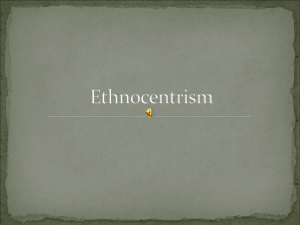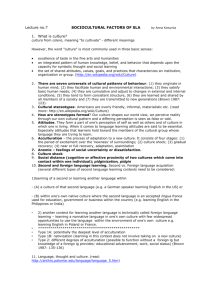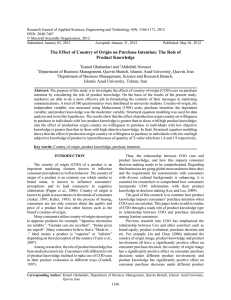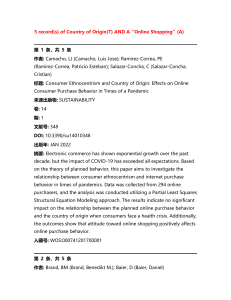Country of Origin Effects
advertisement
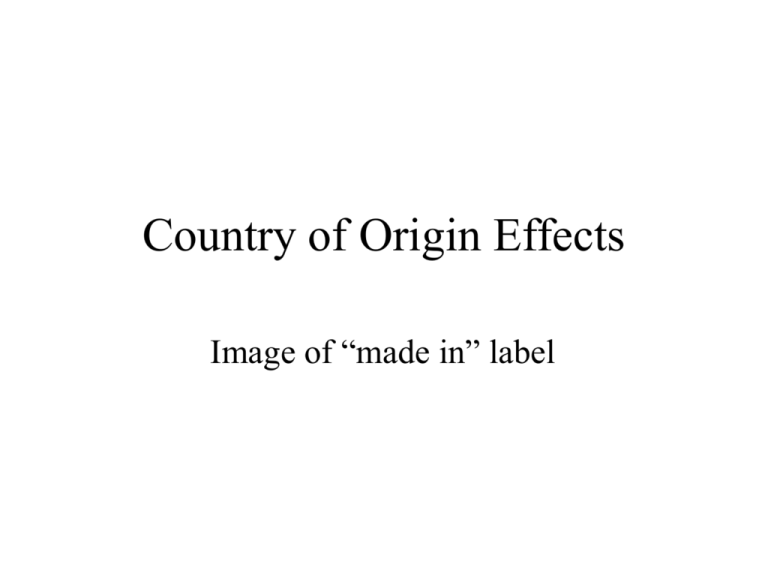
Country of Origin Effects Image of “made in” label COUNTRY OF ORIGIN • WHERE A PRODUCT OR BRAND COMES FROM OFTEN INFLUENCES A CONSUMER PRECEPTION OF THE PRODUCT • COUNTRY-OF-ORIGIN EFFECT = DEALS WITH QUALITY PERCEPTIONS OF PRODUCTS. THIS EFFECT DIFFERS BY PRODUCT CATEGORY AND QUALITY LEVEL OF THE COUNTRY OF PRODUCTION (JOHNY K. JOHANSSON, 2000) • country-of-design, country-of-production • COUNTRY-OF-ORIGIN BIAS = CUSTOMERS TEND TO OVERSTATE THE POSITIVE AND NEGATIVE OF PRODUCT ATTRIBUTES AND THIS CAN CAUSE A BIAS TOWARDS PRODUCTS FROM A GIVEN COUNTRY (JOHNY K. JOHANSSON, 2000) Global Branding • Country of Origin Country with which good/service is associated • Country of Manufacture Country where the product is manufactured (for products) Country where the headquarters are located (for services) • In the absence of other product information, country of origin impacts consumers’ product evaluations ROLE OF BRANDS: CULTURAL DIFFERENCES (JOHNY K. JOHANSSON, 2000) JAPAN US EUROPE IMAGE RISK REDUCTION RECOGNITION/ENVY “FEEL GOOD” TIME SAVER ACHIEVEMENT EMOTIONAL PEER DOMINATION HIGH ASPIRATIONS “BELONGING” DISTINCT PEER RECOGNITION INDIVIDUAL _________________________ ________________________ “VALUE ADDED” AFFECT VALUE CONVENIENT AND SURE __________________________ ________________________ DEFINES THE GROUP IDENTIFIES THE INDIVIDUAL ______________________________ CALCULATED SOCIAL _____________________________ HIGH-LOW STATUS Stereotypes • Product-country stereotypes • Service stereotypes Country of Origin (COO) Stereotypes There is ample evidence that shows that for many products, the “Made in” label matters a great deal to consumers. Key findings: a) COO effects are not stable; perceptions change over time b) In general, consumers prefer domestic products over imports c) The critical factor appears to be the place of manufacture rather than the location of the company’s headquarters d) Demographics makes a difference e) COO effects depend on the product category Strategies to Cope with COO Stereotypes Country image stereotypes can either benefit or hurt a company’s product a) Product Policy; Select a brand name that disguises the country-of-origin or even invokes a favorable COO b) Pricing: low or high price c) Distribution: companies could influence consumer attitudes by using highly respected distribution channels d) Communication Country of Origin, Price, and Brand, as Evaluative Criteria • Country of origin is used to signal product quality • Use of price as criterion varies across product categories: – Acceptable price range is determined by past purchases; perception of benefits vs. costs indicates value; and the buying situation. • Brand reputation – Brand may be viewed as an indicator of quality and/or consistency of satisfaction - lessening risk. Ethnocentrism • The belief that purchasing foreign products hurts the local economy by causing loss of jobs, and that it is morally wrong and unpatriotic • Leads to the rejection of foreign products • Example: US people tend to buy US products BUY AMERICAN! Attitudes Toward Foreign Products • High ethnocentric consumers: purchasing imported products is wrong because it hurts the domestic economy, causes loss of jobs, and is plainly unpatriotic. • Low ethnocentric consumers: foreign products should be evaluated on their own merit, without regard for country-of-origin. Attitude towards the Country of Origin • Stereotyped attitudes toward foreign products & services can favor or hinder marketing efforts • If the quality is perceived to be low – Foreign origin of the product can be disguised – Foreign identification of the product can be continued & consumer attitudes towards the product can be changed • In some market segments foreign products have a substantial advantage because they are foreign
